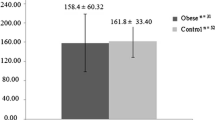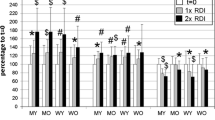Abstract
Nutritional status, referred to meat and vegetable food consumption, is related to folate and B12 vitamin levels; hyperhomocysteinemia (HHcy) is due to folate and B12 vitamin–methionine metabolism imbalance, which can lead to oxidative stress, OS (imbalance between reactive oxygen species, ROS, and total antioxidant capacity, TAC). Possible early vitamin B12 (B12) deficiency can be highlighted by holotranscobalamin (HoloTC, bioactive cobalamin fraction) assay. Erythrocyte folate is a biomarker of 2- to 3-month folate storage. To evaluate nutritional status and OS we conducted an observational study on 118 occupational obese subjects (34M/84F, aged 16–69, median 46.5 years; BMI 26.5–54.1, median 33.3 kg/m2) without previous cardiovascular disease. Serum TAC and ROS (spectrophotometry, Diacron International, Italy), serum B12 and HoloTC, serum and erythrocyte folate, plasma Hcy (immunoenzymatic, AxSYM, Abbott Diagnostics, USA), lipid panel and inflammatory parameters by routine methods. All subjects showed adequate serum and erythrocyte folate levels, but HoloTC values revealed cobalamin deficiency in 30% of cases not congruent with B12 concentrations, low only in 10%. 43% of cases showed mild HHcy (>10.5 μmol/L; median 12.44 μmol/L, IQR 11.2–16.2). OS was found by normal mean TAC values (370.5 micromolHClO/mL, 340–405; n.v. > 350) but increased mean ROS concentrations (386 CarrU, 337–434; n.v. 250–300) in 93% of subjects. Normal folate and B12 vitamin levels revealed a good nutritional status in our occupational obese subjects. The presence of Oxidative Stress, due to imbalance between ROS and TAC and mild hyperhomocysteinemia may heighten the obesity-related cardiovascular risk.
Similar content being viewed by others
References
Van Gaal LF, Mertens IL, De Block CE (2006) Mechanisms linking obesity with cardiovascular disease. Nature 444(14):875–880
Roberts CK, Sindhu KK (2009) Oxidative stress and metabolic syndrome. Life Sci. doi:10.1016/j.lfs.2009.02.026
McCully KS, Wilson RB (1983) Homocysteine theory of arteriosclerosis: development and current status. Atherosclerosis Rev 11:157–246
Finkelstein JD (2006) Inborn errors of sulfur-containing amino acid metabolism. J Nutr 136:1750S–1754S
Selhub J (2006) The many facets of hyperhomocysteinemia: studies from the Framingham cohorts. J Nutr 136:726S–1730S
Konukoglu D, Serin O, Ercan M, Turhan MS (2003) Plasma homocysteine levels in obese and non-obese subjects, with or without hypertension, its relationship with oxidative stress and copper. Clin Biochem 36:405–408
Papatheodorou L, Weiss N (2007) Vascular oxidant stress and inflammation in hyperhomocysteinemia. Antioxid Redox Signal 9:1598–1941
Perna AF, Ingrosso D, De Santo NG (2003) Homocysteine and oxidative stress. Amino Acids 25:409–417
Guzelmeric K, Alkan N, Pirimoglu M et al (2007) Chronic inflammation and elevated homocysteine levels are associated with increased body mass index in women with polycystic ovary syndrome. Gynecol Endocrinol 23:505–510
Ustundag B, Gungor S, Aygun AD et al (2007) Oxidative status and serum leptin levels in obese prepubertal children. Cell Biochem Funct 25:479–483
Terruzzi I, Senesi P, Fermo I et al (2007) Are genetic variants of the methyl group metabolism enzymes risk factors predisposing to obesity? J Endocrinol Invest 30:747–753
Uysal O, Arikan E, Cakir B (2005) Plasma total homocysteine level and its association with carotid intima-media thickness in obesity. J Endocrinol Invest 28:928–934
Herrmann W, Obeid R, Schorr H, Geisel J (2003) Functional vitamin B12 deficiency and determination of Holotranscobalamin in populations at risk. Clin Chem Lab Med 41:1478–1488
Ulleland M, Eilertsen I, Quadros EV et al (2002) Direct assay for cobalamin bound to transcobalamin (Holo-transcobalamin) in serum. Clin Chem 48:526–532
De Vecchi AF, Novembrino C, Patrosso C et al (2003) Effect of incremental doses of folate on homocysteine and metabolically related vitamin concentrations in nondiabetic patients on peritoneal dialysis. ASAIO 49:655–659
Brady J, Wilson L, McGregor L, Valente E, Orning L (2008) Active B12: a rapid, automated assay for Holotranscobalamin on the Abbott AxSYM analyzer. Clin Chem 54(3):567–573
Campise M, Bamonti F, Novembrino C et al (2003) Oxidative stress in kidney transplant patients. Transplantation 76:1474–1478
Landoni G, Mariani E, Oriani G et al (2009) Improvement of antioxidant status in women conventionally treated for breast cancer after 12 months of a cow milk whey-based supplementation. A preliminary study. Mediterranean Journal of Nutrition and Metabolism 2:127–131
Calvelli L, Accinni R, Schiraldi G et al (2007) A Simple and quick instrument for assessing food preferences. Development of the NSAS Scale. Nutrafoods 6:36–39
Vincent HK, Taylor AG (2006) Biomarkers and potential mechanisms of obesity-induced oxidant stress in humans. Int J Obes (Lond) 30:400–418
Olusi SO (2002) Obesity is an independent risk factor for plasma lipid peroxidation and depletion of erythrocyte cytoprotectic enzymes in humans. Int J Obes Relat Metab Disord 26:1159–1164
Skrha J, Sindelka G, Kvasnicka J et al (1999) Insulin action and fibrinolysis influenced by vitamin E in obese Type 2 diabetes mellitus. Diabetes Res Clin Pract 44:27–33
Block G, Dietrich M, Norkus EP et al (2002) Factors associated with oxidative stress in human populations. Am J Epidemiol 156(3):274–285
Keaney JF, Larson MG, Vasan RS et al (2003) Obesity and systemic oxidative stress: clinical correlates of oxidative stress in the Framingham Study. Arterioscler Thromb Vasc Biol 23(3):434–439
Bor MV, Nexo E, Hvas AM (2004) Holotranscobalamin concentration and transcobalamin saturation reflect recent vitamin B12 absorption better than does serum vitamin B12. Clin Chem 50:1043–1049
Miller JW, Garrod MG, Rockwood AL et al (2006) Measurement of total vitamin B12 and Holotranscobalamin, singly and in combination, in screening for metabolic vitamin B12 deficiency. Clin Chem 52:278–285
Clarke R, Sherliker P, Hin H et al (2007) Detection of vitamin B12 deficiency in older people by measuring vitamin B12 or the active fraction of vitamin B12, Holotranscobalamin. Clin Chem 53:963–970
Novembrino C, De Giuseppe R, Uva V et al (2008) Stato carenziale preclinico della vitamina B12 in soggetti asintomatici: importanza del dosaggio dell’olotranscobalamina (vitamina B12 attiva) Ligand Assay 13(3):243–249
Tawakol A, Omland T, Gerhard M, Wu JT, Creater MA (1997) Hyperhomocyst(e)inemia is associated with impaired endotheliumdependent vasodilation in humans. Circulation 95:1119–1121
Loscalzo J (1996) The oxidant stress of hyperhomocys(e)inemia. J Clin Invest 98:5–7
Blundell G, Jones BG, Rose FA, Tudball N (1996) Homocysteine mediated endothelial cell toxicity and its amelioration. Atherosclerosis 122:163–172
Acknowledgments
The authors are very grateful to Mrs Mary Coduri for linguistic consultation.
Conflict of interest
None.
Author information
Authors and Affiliations
Corresponding author
About this article
Cite this article
Vigna, L., Novembrino, C., De Giuseppe, R. et al. Nutritional and oxidative status in occupational obese subjects. Mediterr J Nutr Metab 4, 69–74 (2011). https://doi.org/10.1007/s12349-010-0003-1
Received:
Accepted:
Published:
Issue Date:
DOI: https://doi.org/10.1007/s12349-010-0003-1




